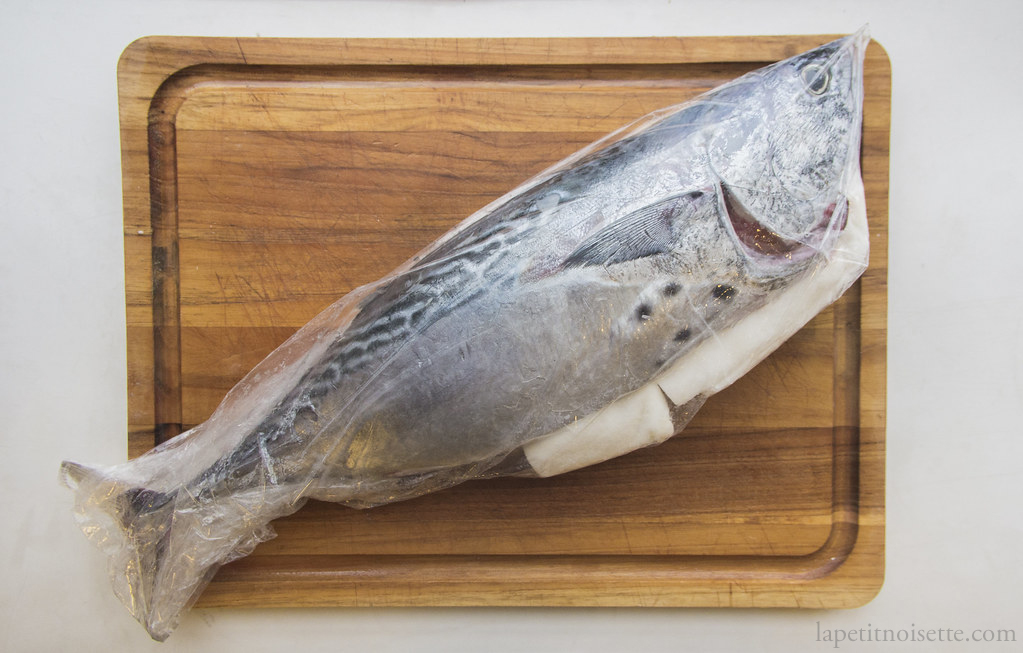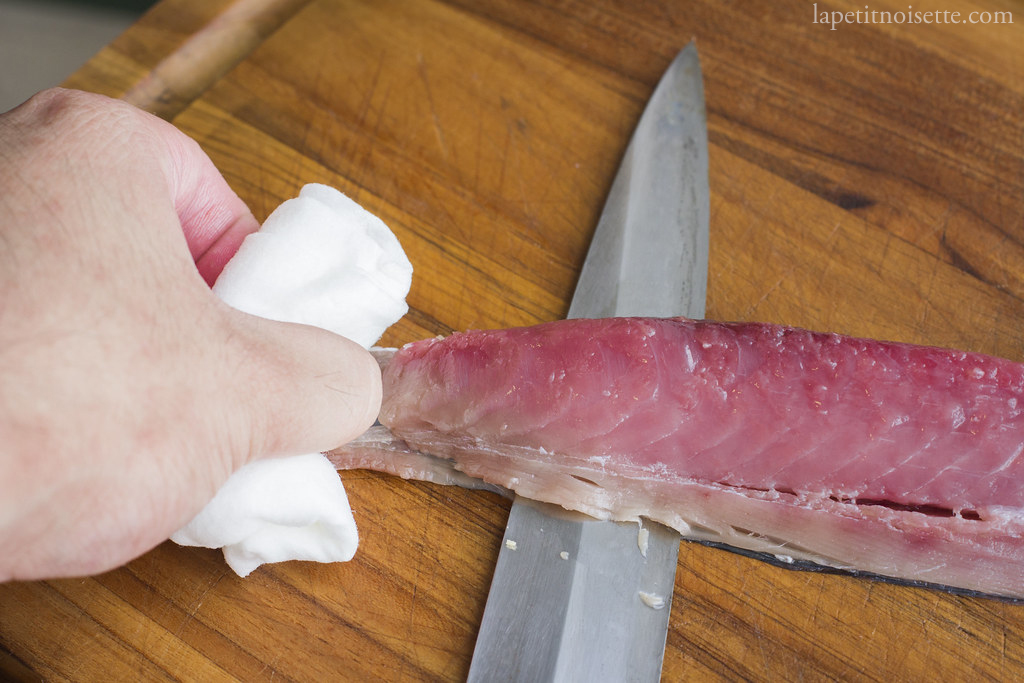
Another very traditional Edomae fish, Skipjack Tuna, or Bonito is a fish that is in season twice in Japan and is caught historically locally in Tokyo Bay. Just like Bluefin Tuna, Skipjack Tuna is migratory and swims around the Island of Japan before swimming off into the ocean. Katsuo that swims around Japan in spring before leaving on its migratory route is know as Hatsu (初) Katsuo, whilst Katsuo caught on it’s return from its migratory route during the autumn is known as Modori (戻り) Katsuo. Both types of Katsuo and symbolic of it’s own season, with the taste of Hatsu Katsuo being likened to the aroma of cherry blossoms in spring, and Modori Katsuo being likened to the aroma of chrysanthemum blooming during the autumn.

This analogy of course, is more symbolic than accurate. There are taste differences between both tunas however. Returning Modori Katsuo has accumulated fat for the on coming winter and has very a thick fat layer. Comparatively, leaving Hatsu Katsuo has been feeding in the rich waters around Japan and whilst not fatty, has a more complex flavour.
Most traditional Edomae sushi restaurants smoke their skipjack Tuna lightly using hay as just to lightly char the skin which otherwise would be too thick to eat. It also imparts a smoky flavour that pairs with the rich red flesh of the tuna, just like a steak cooked on a charcoal grill. In our restaurant however, we age our Katsuo for 3 to 4 days and serve it without smoking. This is because we want to showcase the high quality of our Katsuo.
Edomae-style preperation of Katsuo:

After washing the fish in cold water, start by remove the gills of the fish. Opening the gill flap, insert the tip of the knife into the gill cavity and cut the two ends of the gills connecting the arches.
Next, break the bone connecting the collar of the fish to the head of the fish, allowing you to open the fish. Make a cut down the belly of the fish starting from just below the head all the way to the anus. The cut runs through the pelvic fins, separating them into right and left pelvic fin. The flesh in between the pelvic fin is tough and will require some force. This is why the sharpness of the knife is important. Be careful not to cut yourself.

Open up the entire fish cavity and pull away the innards and gills, cutting away the point at which the gills are attached to the fish.

Rinse the cavity with cold water and clean throughly. Wash the chopping board and wipe dry. The cavity should be completely clean as any remaining dirt will rot during the ageing process.
The fish’s air bladder is located at the centre of the cavity where the rib cage meets the backbone. The air bladder is connected to a blood line that needs to be removed. Cut open the bladder by running the knife through it all the way to the blood line underneath. Whilst under a light stream of cold water, wash the cavity and remove the blood from the blood line. Use an old toothbrush the remove and bit and pieces.
Insert fish paper (Magu roll/マグロッ) or paper towels into the stomach cavity and head cavity of the fish. This is to absorb any excess blood or moisture from inside the fish that would otherwise rot during ageing.

Place the fish inside a large plastic bag and remove all the air from the bag by bunching the end of the plastic bag together and sucking it out with your mouth. Alternatively use a vacuum pack machine. This minimises air exposure during ageing.
Tie the end of the bag to prevent any air from entering. Alternatively, if using a vac pack machine, the machine should automatically seal the bag.

The fish is now ready for ageing. Place in a fridge set at 1-2°C for 1 to 2 days.
After ageing, cut open the bag and remove the fish. Discard the paper towels and place the fish on a chopping board.
Remove the head of the fish and begin the filleting process. (Alternatively, remove the head after the filleting process)
Start by opening the internal cavity of the fish, inserting the tip of the knife and breaking the rib bones, separating them from the backbone.
Next, the flesh starting from the end of the belly cavity all the way down to the tail, angling the blade towards the bone.
Turn the fish around and place the knife above the dorsal fin. Use your other hand to support the fish. In long cutting motions, separate the flesh from the spine of the fish, angling your blade downwards so that you can feel your blade running along the spine, minimising waste. if the long cutting motions prevents the flesh from being damaged too much from multiple cuts. Cut as close to the spine as possible to prevent flesh from being left on the bone.
Continue the cutting motion until the entire fillet is separated from the fish. Making an incision at the tail of the fish and cut off the flesh attaching the fillet to the head. You should be able to see some of the flesh having become brown from the ageing process, cut from these oxidised bits.

Flip your knife so that it is facing upwards and gently separate the rib bones from the flesh just where it meets the pin bones.
Turn your knife back and place the knife under the rib cage, cutting as to gently separate the rib cage from the flesh, angling the knife upwards towards the ribcage to reduce waste. Don’t worry about cutting yourself as the rib cage should be protecting your fingers.
To remove the pin bones, pull the pin bones using a pair of tweezers in the direction towards the head. Pulling the pin bones towards the tail is easier but will damage the flesh. Dip the tweezers in water to clean them occasionally. Repeating until you can not feel anymore pin bones. Remember to use a firm grip as not to break the pin bones, leaving bone fragments inside the fish. It is better to pull the pin bones slowly and steadily, rather than quickly.
To finish preparing the Katsuo, repeat for the other side of the fish to extract another fillet.
Cut the fillet in half to make the Katsuo more manageable.


Remove the skin off the fillets by making a small cut underneath the tail of the fillet between the flesh and skin. Start by cutting into the flesh and stopping just at the skin. When the blade just touches the skin, use a back and forth motion on the skin to gently separate the fresh from the skin whilst angling the blade until it is flat. The blade should remain still whilst you only move the skin.

Continue the cutting motion until all the skin has been removed from the flesh. If the skin breaks halfway, don’t worry and start from the other end of the fillet. Using a paper towel to grip the skin of the fish allows you to have a more stable hold on the fillet, making it easier to cut.
Nice article and very well written.
But I think the picture of the hole Fish is actually not a Katsuwonus pelamis / Katsuo / Skipjack – because the fish has dots on its belly I think this picture shows an Euthynnus affinis / Suma / Kawakawa – am I correct?
We actually caught two of that fish last week of the coast of Tunesia
Yes you’re actually totally correct! That’s amazing knowledge of fish you have right there. I did actually realize that just when I had finished writing that article but didn’t have the time or resources to fix it.
This is exciting. I was researching Katsuo Furikake for rice seasoning. I want to try something different because I love Asian foods. I have learned a lot from your article. My mom could fillet a whole with a blink of an eye. So to me it’s a fine art to do it correct. Especially for the different types of fish.
Thank you for doing this educational article.